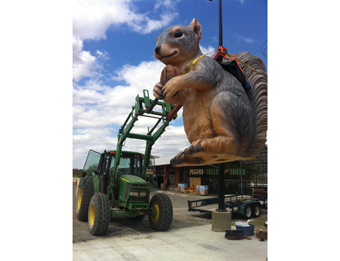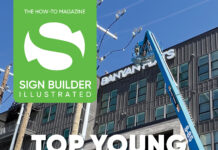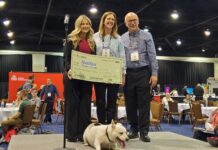 When it comes to envisioning new possibilities in the shape of signage, Austin, Texas-based Blue Genie Art is at the forefront of this work. Founded in 1999 by Rory Skagen, Dana Younger, and current Principal Kevin Collins, this group of artists merged their respective small businesses to direct their talents into commercial work.
When it comes to envisioning new possibilities in the shape of signage, Austin, Texas-based Blue Genie Art is at the forefront of this work. Founded in 1999 by Rory Skagen, Dana Younger, and current Principal Kevin Collins, this group of artists merged their respective small businesses to direct their talents into commercial work.
With a collective portfolio encompassing mural work, sculpture, and design, the group was uniquely positioned to compete in the field of custom signage design. The result: The signs they are typically asked to create employ a sculptural or whimsical component.
What has made their work possible is the equipment used. “In our fifteen years of working in this business, the biggest innovation has been digital scanning and CNC milling of shapes—both have radicalized our process,” says Collins. “We build many of our shapes out of urethane or EPS foam, which are then painted and hard-coated with a polyurethane—although we can use a variety of materials from polyurethanes, metal, epoxies, concrete, etc.
“It all depends on what the specifications are for the jobs.”
For example, they crafted a twelve-foot-tall “roadside attraction” squirrel for the Berdoll Pecan Farm in Cedar Creek, Texas out of wood, foam, and steel (see above). “They intended it as a photo op for visitors and a supplementary asset to their giant on-premise LED sign,” says Collins.
Blue Genie Art also used their four-axis router to create a “devilish” 3-D sign for Torchy’s Taco. “We translated their 2-D logo by sculpting it first as a small maquette, then digitally scanning it, and translating into a CNC file,” says Collins.
{2j_imageviewer 29}
They built a 15-7/12-foot PEZ dispenser out of steel and foam for the PEZ Visitors Center outside their factory in Orange, Connecticut. “We created its cabinet out of MDF and the foot of the dispenser out of fiberglass,” says Collins.
And when social media management company HootSuite wanted to make a big splash with an old CARTS airport shuttle bus at this past spring’s South By Southwest Interactive Festival in Austin, Blue Genie designed a vinyl wrap for it and made the painted sculptures for it out of foam and wood. “They used it transport their street team, while their guy dressed like their owl mascot fires off t-shirts from it with a t-shirt cannon,” explains Collins.
When clients approach Blue Genie, they’re usually prepared to ask for a custom, one-of-a-kind showpiece—a figure, a sculpture, or even an animal-shaped vehicle—without necessarily imagining how dynamic the outcome will be.
“Only about one out of a hundred clients beginning this process understand the power of what dimensional signage can provide over more traditional signs, but I have never had a client come back to me with buyer’s remorse,” says Collins. “For attracting attention in the current climate, you have to make an immediate and lasting impression. We do that.”
The brains behind the company’s work are referred to as “fun-gineers.” This outside design team does test loads and makes appropriate recommendations for working with what Collins refers to as “oddball stuff.” He notes that there are occasions where dimensional work falls outside of typical permitting (but doesn’t compromise safety). In cases such as rooftop sculptures or other unique forms, the company designates the work as art rather than signage.
Collins says, “We ask a lot of questions about the performance of the sign. We also follow current trends in art and signage. This involves avoiding the headache of something that is simply not built to last.”
Looking ahead to the technologies and equipment that will improve dimensional sign making in the future, the focus is on integration. “I’m really excited about the intersection of technologies, especially with CNC/laser cutting/rapid prototyping, and that these tools are becoming increasingly accessible to designers, architects, and even hobbyists,” says Collins. “This integration even makes it possible to upgrade static signage or the architectural character of buildings.”
—Lori Shridhare











